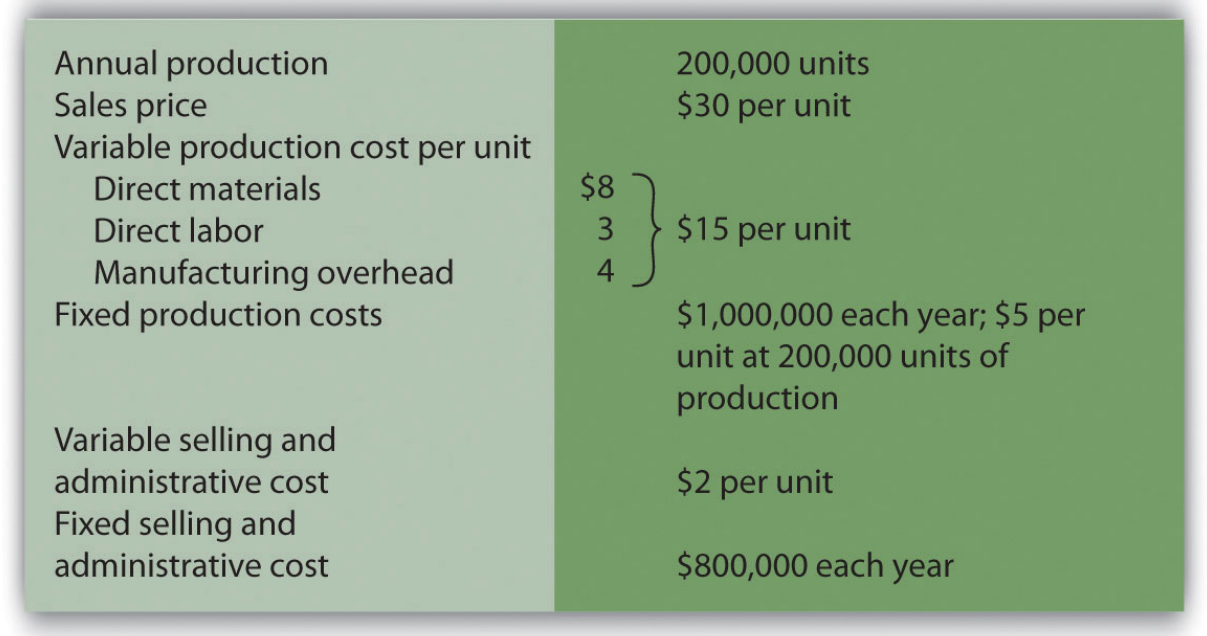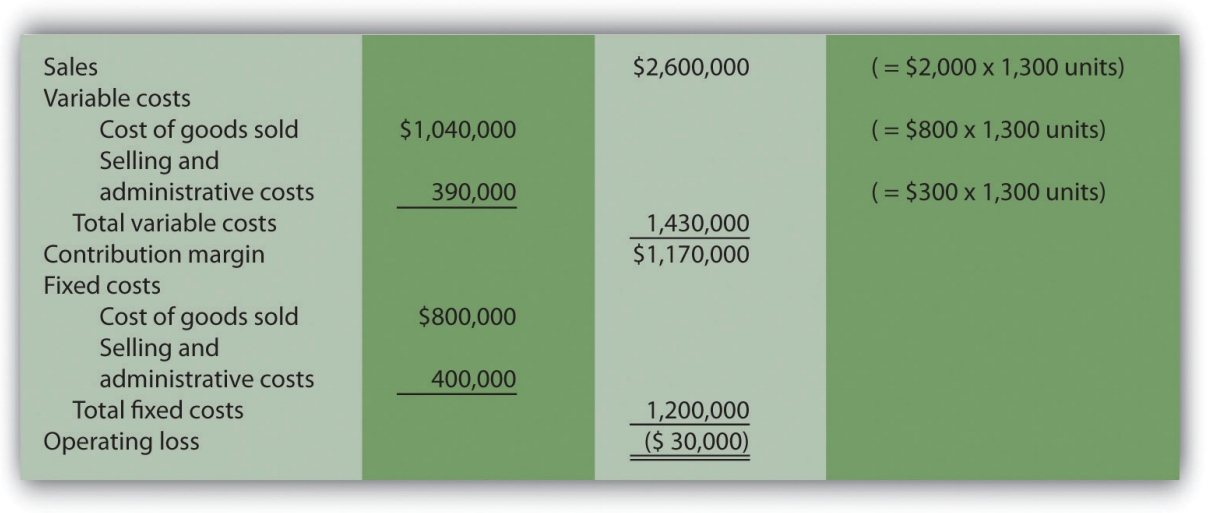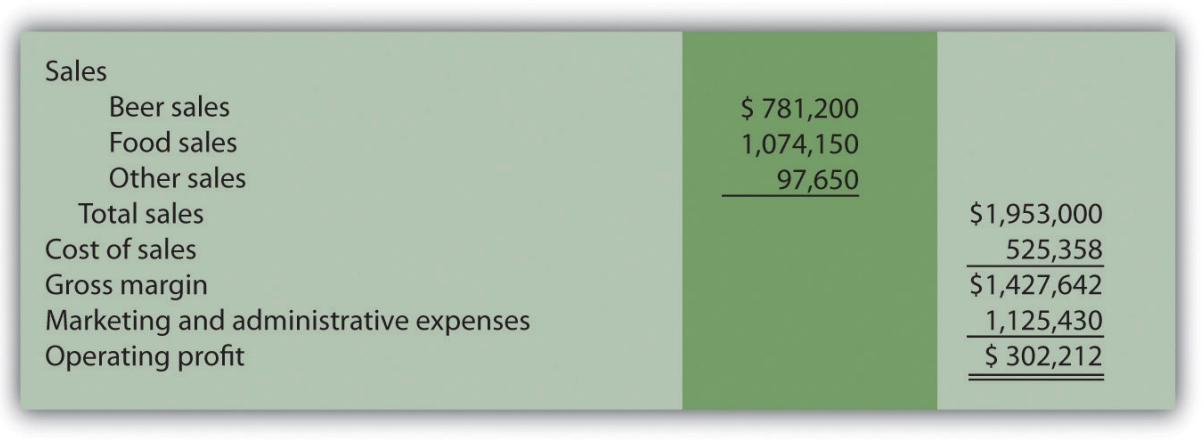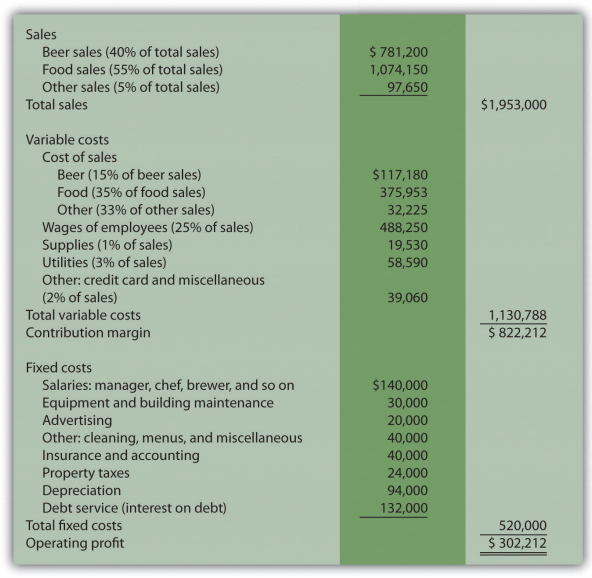30 4. Exercises (Part 2)
Problems
- CVP and Sensitivity Analysis (Single Product). Madera Company has annual fixed costs totaling $120,000 and variable costs of $3 per unit. Each unit of product is sold for $15. Madera expects to sell 12,000 units this year (this is the base case).
Required:
- Find the break-even point in units.
- How many units must be sold to earn an annual profit of $50,000? (Round to the nearest unit.)
- Find the break-even point in sales dollars.
- What amount of sales dollars is required to earn an annual profit of $70,000?
- Find the margin of safety in units and in sales dollars.
- Prepare a contribution margin income statement for the base case.
- What will the operating profit (loss) be if the sales price decreases 30 percent? (Assume total sales remains at 12,000 units, and round to the nearest cent where appropriate.)
- Go back to the base case. What will the operating profit (loss) be if the variable cost per unit increases 10 percent? (Assume total sales remains at 12,000 units, and round to the nearest cent where appropriate.)
- CVP Analysis and Cost Structure (Single Product). Riviera Incorporated produces flat panel televisions. The company has annual fixed costs totaling $10,000,000 and variable costs of $600 per unit. Each unit of product is sold for $1,000. Riviera expects to sell 70,000 units this year.
Required:
- Find the break-even point in units.
- How many units must be sold to earn an annual profit of $2,000,000?
- Find the break-even point in sales dollars.
- What amount of sales dollars is required to earn an annual profit of $500,000?
- Find the margin of safety in units.
- Find the margin of safety in sales dollars.
- How much will operating profit change if fixed costs are 15 percent higher than anticipated? Would this increase in fixed costs result in higher or lower operating leverage? Explain.
- CVP Analysis with Taxes (Single Product). Riviera Incorporated produces flat panel televisions. The company has annual fixed costs totaling $10,000,000 and variable costs of $600 per unit. Each unit of product is sold for $1,000. Riviera expects to sell 70,000 units this year (this is the same data as the previous problem). Assume a tax rate of 30 percent.
Required:
Round all calculations to the nearest dollar and nearest unit where appropriate.
- How many units must be sold to earn an annual profit of $2,000,000 after taxes?
- What amount of sales dollars is required to earn an annual profit of $500,000 after taxes?
- Refer to requirement a. What would happen to the number of units required to earn $2,000,000 in operating profit if the company were a non-profit organization that did not incur income taxes? Explain. (Detailed calculations are not necessary but may be helpful in confirming your answer.)
- CVP Analysis and Sales Mix (Multiple Products). Sierra Books Incorporated produces two different products with the following monthly data (this is the base case).
| Text | Lecture Notes | Total | |
|---|---|---|---|
| Selling price per unit | $100 | $12 | |
|
Variable cost
per unit |
$60 | $3 | |
| Expected unit sales | 21,000 | 14,000 | 35,000 |
|
Sales mix
|
60 percent | 40 percent | 100 percent |
| Fixed costs | $750,000 |
Assume the sales mix remains the same at all levels of sales except for requirement i.
Required:
Round to the nearest unit of product, hundredth of a percent, and nearest cent where appropriate. (An example for unit calculations is 3,231.15 = 3,231; an example for percentage calculations is 0.434532 = 0.4345 = 43.45 percent; an example for dollar calculations is $378.9787 = $378.98.)
- Calculate the weighted average contribution margin per unit.
-
- How many units in total must be sold to break even?
- How many units of each product must be sold to break even?
-
- How many units in total must be sold to earn a monthly profit of $100,000?
- How many units of each product must be sold to earn a monthly profit of $100,000?
- Using the base case information, prepare a contribution margin income statement for the month similar to the one in Figure 6.5.
- Calculate the weighted average contribution margin ratio.
- Find the break-even point in sales dollars.
- What amount of sales dollars is required to earn a monthly profit of $80,000?
- Assume the contribution margin income statement prepared in requirement d is the company’s base case. What is the margin of safety in sales dollars?
- If the sales mix shifts more toward the Text product than the Lecture Notes product, would the break-even point in units increase or decrease? Explain. (Detail calculations are not necessary, but may be helpful in confirming your answer.)
- CVP Analysis and Cost Structure (Service Company). Conway Electrical Services provides services to two types of clients: residential and commercial. The company’s contribution margin income statement for the year is shown (this is the base case). Fixed costs are known in total, but Conway does not allocate fixed costs to each department.

Required:
- Find the break-even point in sales dollars.
- What is the margin of safety in sales dollars?
- What amount of sales dollars is required to earn an annual profit of $750,000?
- Refer to the base case shown previously. What would the operating profit be if the Commercial variable costs are 20 percent higher than originally anticipated? How does this increase in Commercial variable costs impact the operating leverage of the company?
- CVP and Sensitivity Analysis, Resource Constraint (Multiple Products). Hobby Shop Incorporated produces three different models with the following annual data (this is the base case).
| Plane | Car | Boat | Total | |
|---|---|---|---|---|
| Selling price per unit | $20 | $14 | $24 | |
|
Variable cost
per unit |
$ 5 | $ 7 | $ 8 | |
| Expected unit sales | 30,000 | 50,000 | 20,000 | 100,000 |
|
Sales mix
|
30 percent | 50 percent | 20 percent | 100 percent |
| Fixed costs | $650,000 |
Assume the sales mix remains the same at all levels of sales except for requirements i and j.
Required:
Round to the nearest unit of product, hundredth of a percent, and nearest cent where appropriate. (An example for unit calculations is 3,231.151 = 3,231; an example for percentage calculations is 0.434532 = 0.4345 = 43.45 percent; an example for dollar calculations is $378.9787 = $378.98.)
- Calculate the weighted average contribution margin per unit.
-
- How many units in total must be sold to break even?
- How many units of each product must be sold to break even?
-
- How many units in total must be sold to earn an annual profit of $500,000?
- How many units of each product must be sold to earn an annual profit of $500,000?
- Using the base case information, prepare a contribution margin income statement for the year similar to the one in Figure 6.5.
- Calculate the weighted average contribution margin ratio.
- Find the break-even point in sales dollars.
- What amount of sales dollars is required to earn an annual profit of $400,000?
- Go back to the base case contribution margin income statement prepared in requirement d. What would the operating profit be if the Plane sales price (1) increases 10 percent, or (2) decreases 10 percent? (Assume total sales remains at 100,000 units.)
- Go back to the base case contribution margin income statement prepared in requirement d. If the sales mix shifts more toward the Car product than to the other two products, would the break-even point in units increase or decrease? (Detailed calculations are not necessary.) Explain.
- Assume the company has a limited number of labor hours available in production, and management would like to make efficient use of these labor hours. The Plane product requires 4 labor hours per unit, the Car product requires 3 labor hours per unit, and the Boat product requires 5 hours per unit. The company sells everything it produces. Based on this information, calculate the contribution margin per labor hour for each model (round to the nearest cent), and determine the top two models the company would prefer to sell to maximize overall company profit.
-
Absorption Costing Versus Variable Costing. Wall Tech Company produces wood siding. The company has no finished goods inventory at the beginning of year 1. The following information pertains to Wall Tech Company.

Required:
- All 200,000 units produced during year 1 are sold during year 1.
- Prepare a traditional income statement assuming the company uses absorption costing.
- Prepare a contribution margin income statement assuming the company uses variable costing.
- Although 200,000 units are produced during year 2, only 170,000 units are sold during the year. The remaining 30,000 units are in finished goods inventory at the end of year 2.
- Prepare a traditional income statement assuming the company uses absorption costing.
- Prepare a contribution margin income statement assuming the company uses variable costing.
- Although 200,000 units are produced during year 3, a total of 230,000 units are sold during the year. The 30,000 units remaining in inventory at the end of year 2 are sold during year 3.
- Prepare a traditional income statement assuming the company uses absorption costing.
- Prepare a contribution margin income statement assuming the company uses variable costing.
- Analyze the results in years 1 through 3 (requirements a through c).
One Step Further: Skill-Building Cases
- Internet Project: CVP Analysis. Using the Internet, go to the Web site for Nordstrom, Inc. (http://www.nordstrom.com), and select investor relations. Find the most recent annual report and print the income statement (called the consolidated statements of earnings).
Required:
- Calculate the gross profit percentage (also called the gross margin percentage) by dividing the gross profit by net sales.
- Explain how the gross profit percentage is different than the contribution margin ratio (no calculations are necessary)?
- Decision Making: Automated Versus Labor Intensive Production. Wood Furniture, Inc., builds high-quality wood desks. Management of the company is considering going from a labor-intensive process of building desks to an automated process that requires expensive machinery and equipment. If the company moves to an automated process, variable production costs will decrease ( direct materials, direct labor, and variable manufacturing overhead) due to improved efficiency, and fixed production costs will increase as a result of additional depreciation costs. The costs predicted for the coming year are shown. The selling price is expected to be $900 per unit for both processes.
| Labor-Intensive Process | Automated Process | |
|---|---|---|
|
Variable cost
of goods sold |
$490 per unit | $290 per unit |
|
Fixed cost
of goods sold (annual) |
$1,000,000 | $2,600,000 |
| Variable selling and administrative | $10 per unit | $10 per unit |
| Fixed selling and admin. (annual) | $400,000 | $400,000 |
Required:
- Calculate the break-even point in units assuming that (1) the labor-intensive process is used, and (2) the automated process is used.
- Explain why there is such a significant difference in break-even points between the labor-intensive process and the automated process.
- Assume Wood Furniture, Inc., expects to produce and sell 8,000 units this coming year and is certain sales will grow by at least 10 percent per year in future years. Calculate the expected operating profit assuming that (1) the labor intensive process is used, and (2) the automated process is used.
- Using requirement c as a guide, explain whether management should stay with the labor-intensive process or switch to an automated process.
- Group Activity: Sensitivity Analysis and Decision Making. Performance Sports produces inflatable rafts used for river rafting. Sales have grown slowly over the years, and cost increases are causing Performance Sports to incur losses. Financial data for the most recent year are shown.

Members of the management group at Performance Sports arrived at these three possible courses of action to return the company to profitability (each scenario is independent of the others):
- Increase the sales price for each raft by 10 percent, which will cause a 5 percent drop in sales volume. Although sales volume will drop 5 percent, the group believes the increased sales price will more than offset the drop in rafts sold.
- Decrease the sales price for each raft by 10 percent, which will cause an 8 percent increase in sales volume. Although the sales price will drop by 10 percent, the group believes an increase in rafts sold will more than offset the sales price reduction.
- Increase advertising costs by $200,000, which will increase sales volume by 15 percent. Although fixed selling and administrative costs will increase by $200,000, the group believes the increase in rafts sold will more than offset the increase in advertising costs.
Required:
Form groups of two to four students and assign one of the three options listed previously to each group. Each group must perform the following requirements:
- Calculate the projected operating profit (loss) for the option assigned, and determine whether the option is acceptable.
- Discuss and document the advantages and disadvantages of the option assigned.
- As a class, discuss each option based on the findings of your group.
-
Sensitivity Analysis Using Excel. Refer to the information for Performance Sports in Skill-Building Case 60. Prepare an Excel spreadsheet to calculate the operating profit (loss) for the base case and for each of the three scenarios presented in the case. Using the spreadsheet in the Computer Application box in this chapter as a guide, include “data entry” and “ sensitivity analysis results” sections, and combine variable cost of goods sold and selling and administrative costs on one line and fixed cost of goods sold and selling and administrative costs on another line.
- Ethics: Increasing Production to Boost Profit. Hauser Company produces heavy machinery used for snow removal. Over half of the production costs incurred by Hauser are related to fixed manufacturing overhead. Although the company has maximum production capacity of 20,000 units per year, only 2,000 units were produced and sold during year 1, yielding $25 million in operating losses. As required by U.S. GAAP, the company uses absorption costing.At the beginning of year 2, the board of directors fired the president of the company and began searching for a new president who was willing to make substantial changes to get the company turned around. One candidate, Paul Glezner, indicated he could turn the company around within a year. He felt the company was producing too few products, and could benefit from increased production. The members of the board of directors were impressed and considered Paul’s contract demands: $10,000 in base annual salary, plus 30 percent of operating profit. Paul made it clear he would help the company for year 2, but intended to move on after the year ended.Management of Hauser Company approached you with Paul’s offer and asked you to determine whether the offer is reasonable.
Required:
- Assume the company’s sales will remain close to 2,000 units in year 2. How does Paul intend to “turn the company around” during year 2?
- Why do you think Paul insists on leaving the company after year 2?
- What type of costing system would you recommend Hauser Company use during year 2? Explain.
Comprehensive Case
- CVP and Sensitivity Analysis for a Brewpub. As described in Note 4.37 “Business in Action 4.2”, three entrepreneurs were looking for private investors and financial institutions to fund a new brewpub near Sacramento, California. This brewpub was to be called Roseville Brewing Company (RBC).
Brewpubs provide two products to customers: food from the restaurant segment, and freshly brewed beer from the beer production segment. Both segments are typically in the same building, which allows customers to see the beer brewing process.
After months of research, the three entrepreneurs created a financial model that showed the following projections for the first year of operations:

In the process of pursuing capital (cash) through private investors and financial institutions, they were asked several questions. The following is a sample of the questions most commonly asked:
- What is the break-even point?
- What sales dollars will be required to make $200,000? To make $500,000?
- Is the product mix reasonable? (Beer tends to have a higher contribution margin ratio than food, and therefore product mix assumptions are critical to profit projections.)
- What happens to operating profit if the product mix shifts?
- How will changes in price affect operating profit?
- How much does a pint of beer cost to produce?
It became clear that the initial financial model was not adequate for answering these questions. After further research, the entrepreneurs created another financial model that provided the following information for the first year of operations. (Notice that operating profit of $302,212 is the same as in the first model.)

Required:
Round your answers to the nearest hundredth of a percent and nearest dollar where appropriate. (An example for percentage calculations is 0.434532 = 0.4345 = 43.45 percent; an example for dollar calculations is $378.9787 = $379.)
- What were potential investors and financial institutions concerned about when asking the questions listed previously?
- Why was the first financial model inappropriate for answering most of the questions asked by investors and bankers? Be specific.
- Suppose you are deciding whether to invest in RBC. Which financial ratio would you use to check the reasonableness of RBC’s projected operating profit as compared with that of similar businesses?
- Why is it difficult to answer the question “How much does a pint of beer cost to produce?” Which costs would you include in answering this question?
- Perform CVP analysis by answering the following questions:
- What is the break-even point in sales dollars for RBC?
- What is the margin of safety in sales dollars for RBC?
- Why is it not possible for RBC to find the break-even point in units?
- What sales dollars would be required to achieve an operating profit of $200,000 and of $500,000? What assumptions are made in these calculations?
- Assume total revenue remains the same, but the product mix changes so that each of the three revenue categories is weighted as follows: food 70 percent, beer 25 percent, other 5 percent. Prepare a contribution margin income statement to reflect these changes. How will this shift in product mix affect operating profit?
- Although the financial model is important, what other strategic factors should RBC and its investors consider?


